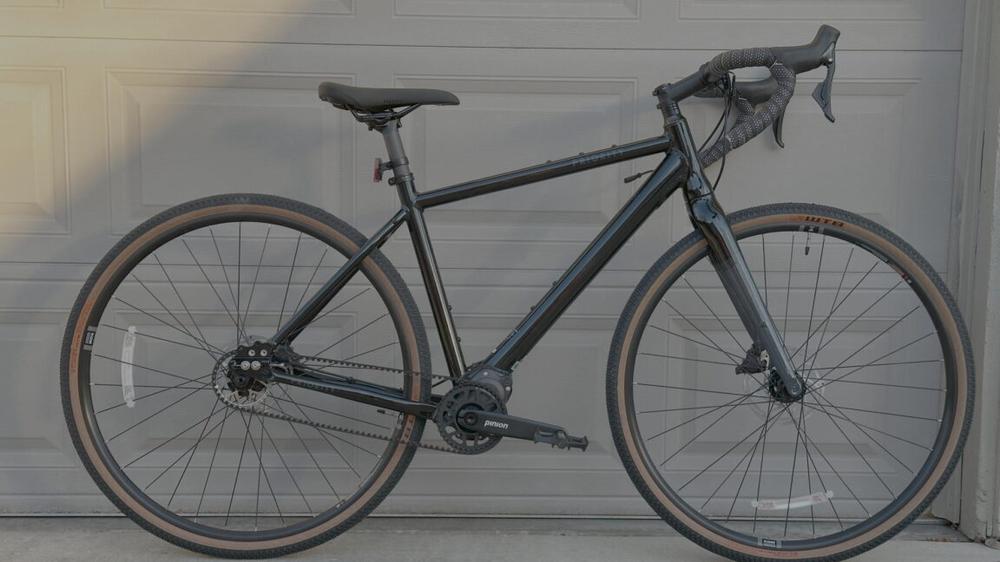In combining a belt drive with a gravel bike, Priority Bicycles has put a smart idea into action with the Apollo Gravel. The execution is mostly there, although the Apollo is perhaps best described as a fantastic commuter bike with a solid gravel upside—as long as the road isn't too rough.
The Apollo Gravel comes in both aluminum and titanium frames. I tested the $1,999 aluminum model; the titanium version retails for $3,999. The aluminum version weighs in at 24 lb (10.9 kg), about a half-pound more than the titanium version, and comes with 40 mm WTB tires, WTB i23 ST tubeless-ready wheels (our test bike had inner tubes), and semi-hydraulic disc brakes. Both models use the Shimano Alfine 11 hub and a Gates Carbon Drive Belt, although our test model showed up with the Pinion Smart.Shift instead of the Alfine hub listed on the Apollo's spec sheet.
No mess, no fuss
At first glance, a belt drive and internal gear hub seem the perfect match for a gravel bike. But implementation is key, and Priority has largely nailed it. Regular gravel grinding means regularly washing your bike and lubricating the chain. While the Apollo got dirty and needed to be hosed off, there were no gloves or chain lube involved. There were also no worries about dirt and dust making their way into a derailleur or coating the cassette. Belt drives are also dead quiet and have an excellent reputation for longevity, lasting up to three times longer than a chain.
What about that internal gear hub? The internal hub in the Apollo offers a 409 percent gear range. By comparison, the Trek Checkpoint SL 7 we reviewed last year has a typical gear ratio for a 1x gravel bike, topping out at 400 percent (40t chainring and 10-42 cassette).
The Pinion Smart.Shift gearbox can be adjusted with an app. We used it to swap shifter buttons so that the larger paddle shifts to higher gears and the smaller to lower. There's also an auto-shift option, which will shift to a selected gear when stopping. It works well enough that we eventually forgot about downshifting before stopping at a red light. If you're the type of rider who tries to avoid coming to a complete stop whenever possible, you will find this feature less useful.
What happens if you get a flat? We had some concerns that the tension of the belt would make removing and reinstalling the wheel more difficult. Those fears proved unfounded—the wheel came off easily, and the belt popped off the front chainring into an oval shape. And putting the wheel and belt back on was also easy—no more difficult than wrangling a rear derailleur and small cog on a standard bike.
If you really want to fine-tune the belt drive, download the Gates Carbon Drive app. The app uses a smartphone microphone to pick up the frequency of the belt as it's plucked like a guitar string. We were able to use sliding dropouts to adjust the tension so the belt resonated within the ideal 45–65 Hz range.
Of trails and roads
Despite the name, the Apollo Gravel feels more suited as a commuter bike than a gravel bike. The Apollo was more than capable of handling the local, groomed limestone gravel paths. But it's a rougher ride on cruddy terrain. Running lower tire pressures on a tubeless setup would improve the ride quality (the Apollo showed up with inner tubes inside)—and we found ourselves wondering how much more compliant the titanium-framed version would be—but the Apollo is fine on most gravel surfaces.
It's no speed demon—if you're looking for something to race, this isn't it, as the Apollo is designed more for long, leisurely gravel rides. It was fantastic on a 68-mile jaunt down the Kal-Haven Trail with Space Editor Eric Berger, but it's not the bike for exploring those single-track paths leading off the main trail.
It's almost the perfect commuter bike. The slightly flared (6-degree) drop bars help the rider settle into a comfortable riding position, and the belt drive is nearly silent. Best of all, we were able to hose the bike off after a wet or muddy ride without having to dry off and lubricate a chain. That's a big win for winter and springtime commuting. The Apollo also has rack mounts (in addition to two water bottle cage mounts and mounts for a top tube bag) for bikepacking or commuting.
We noticed a couple of irritants with the Apollo. First, there's no way to tell which gear you're in. Well, that's not entirely true—if you have your phone in a mount with the Pinion app running, you can see your gearing. Unfortunately, the Pinion gearbox won't pair with a cycling computer, so there's no way to check your gearing as is possible with electronic groupsets from SRAM and Shimano.
Shifting could be touchy at times. The belt drive is sensitive to excessive torque, so we found that shifts sometimes did not register when pedaling too hard. During our testing, we learned to ease up when shifting, but we found this mildly annoying at times. Lastly, the charge port for the gearbox is on the end of a wire that just flops around in an annoying and unsightly fashion.
Annoyances to be sure, but these are far from deal-breakers for this bicycle. Being able to tweak the shifting and make minor adjustments via an app are useful features to have, and the belt drive makes cleanup after dirty rides a breeze. Best of all, the $1,999 price is competitive with the lower-end gravel offerings from the likes of Trek and Specialized. If you're looking for a low-maintenance daily driver, the Apollo Gravel fits the bill.
This story was updated to emphasize that this bike shipped with a Pinion Smart.Shift hub instead of the Shimano hub listed on the specs page.

 Le 5 migliori offerte tech: Xiaomi Pad 7, Samsung QLED e altro
Le 5 migliori offerte tech: Xiaomi Pad 7, Samsung QLED e altro